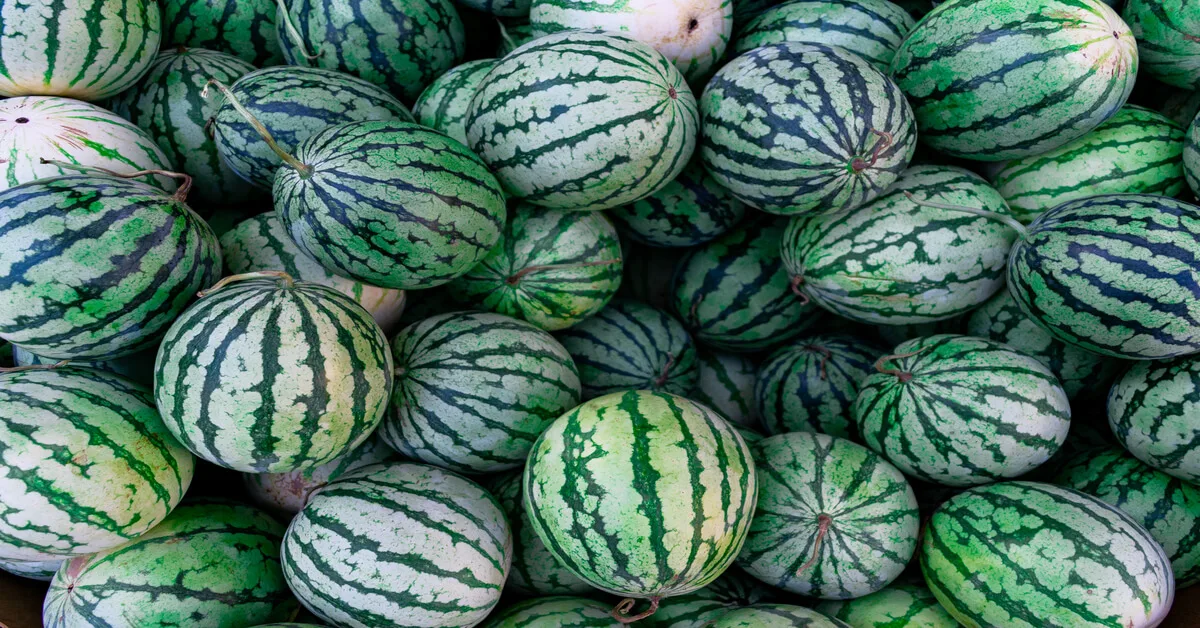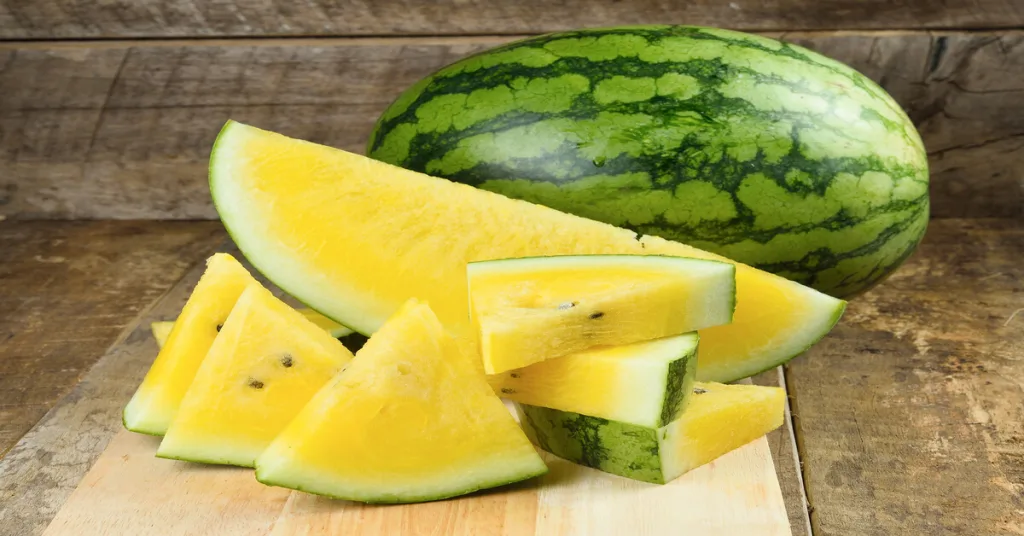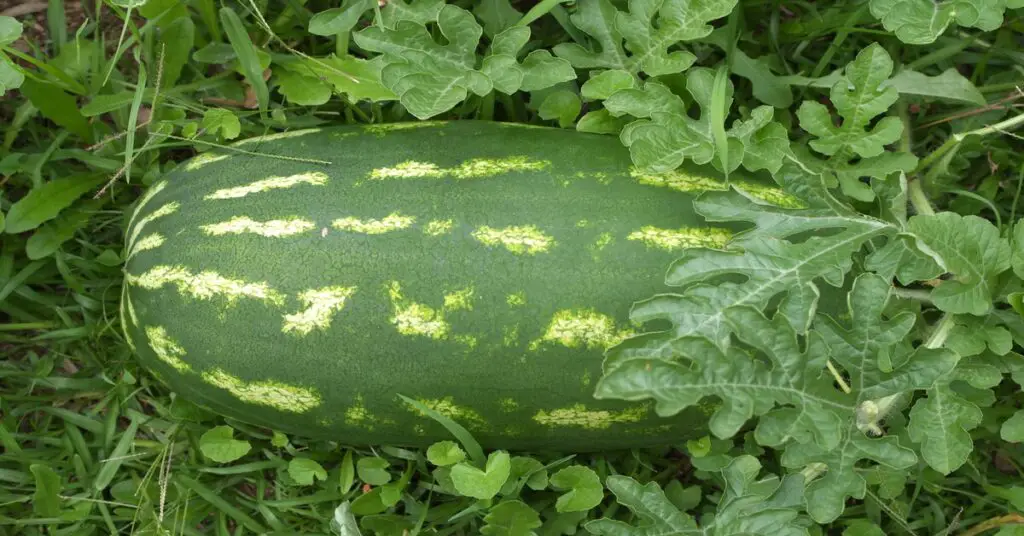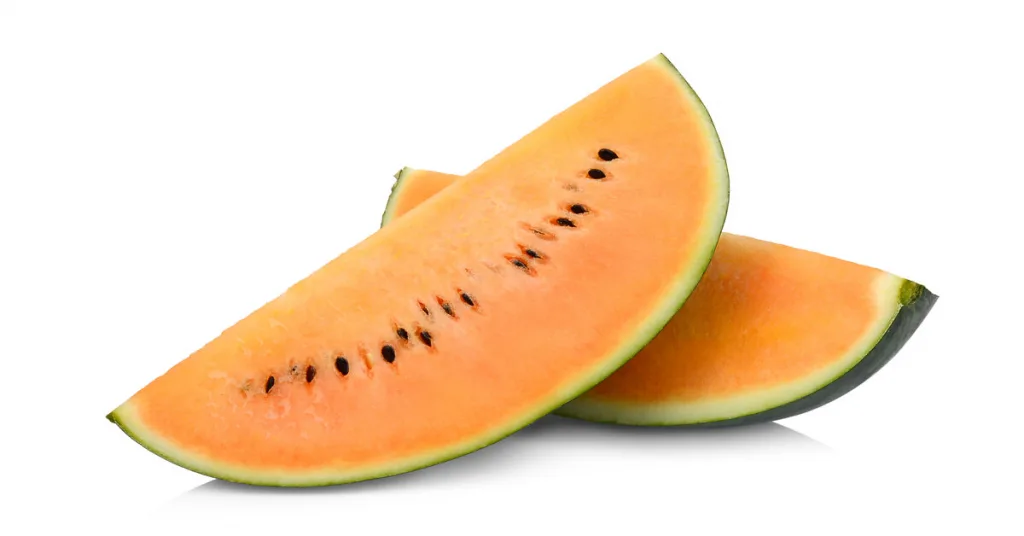Yellow watermelons are naturally occurring varieties of watermelons (Citrullus lanatus). Which have been cultivated alongside red watermelons for thousands of years.
With their bright yellow flesh and crisp, refreshing taste, these sweet treats make a delicious and vibrant addition to your summertime fruit platter.
Yellow watermelons grow in similar conditions to red watermelons, and they are known for their sweet, honey-like, and juicy flesh.
In this article, we’ll explore the many interesting varieties of yellow watermelons.
What is Yellow Watermelon?
A yellow watermelon is a naturally occurring type of watermelon that is characterized by yellow flesh, rather than the typical pink or red color.
Yellow, red, and orange watermelons are all sweet varieties. And they may have been selectively bred by humans in North Africa from the more bitter-fleshed white wild varieties of bitter-fleshed melons.
The earliest archaeological evidence of watermelon domestication appears in a bitter-fleshed watermelon seed found in Libya that is 5,000-8,650 years old.
Archaeological evidence and genetic analysis indicate that both red, orange, and yellow sweet watermelons were cultivated from white and bitter-fleshed watermelons. Between 4,350 and 3,500 years ago in the upper Nile valley, in present-day Sudan. [1]
7 Yellow Watermelon Varieties

Regardless of their origins, yellow watermelons are enjoyed by many around the world. Below are some popular varieties to try and grow in your own garden:
- Yellow Crimson
Yellow Crimson watermelons are a popular choice for home gardeners and farmers. Due to their sweet flavor and attractive appearance. They are easy to grow and produce fruit throughout the summer.
- Size: Produces small to medium watermelons (5-10 lbs or 2.2-4.5 kg), with a round shape and smooth, dark green rind.
- Flavor: Yellow Crimsons are known for their sweet, crisp flesh. They have a juicy, refreshing flavor that is popular among watermelon enthusiasts.
- Seeds: Both seeded and seedless varieties exist.
- Growth:75-85 days to reach maturity. Indeterminate.
- Yellow Doll

Yellow dolls are early-maturing, green striped hybrid watermelons with bright lemon yellow, extra sweet, seeded flesh with a dense and crisp texture. These watermelons can be grown on a trellis when space is limited.
- Size: Small fruits averaging 5-8 lbs (2.3-4 kg). Perfect for small spaces.
- Flavor: Known for their juicy, sweet flesh, these watermelons have a refreshing flavor.
- Seeds: Some varieties are seeded, while others have small, edible seeds.
- Growth: 68-70 days to reach maturity. Semi-determinate compact vines.
- Super Gold
Super Gold is a hybrid variety known for its golden flesh and sweet taste. It is a popular choice for both commercial and home gardeners due to its unique flavor and appearance. As well as its resistance to many common pests and diseases. Super Gold is used in desserts and fruit salads and is excellent for juicing.
- Size: Large fruits averaging 15-20 lbs (7-9 kg). Round or oblong shapes that are relatively uniform in size and shape.
- Flavor: Known for sweet, juicy flesh and high sugar content.
- Seeds: Seeds are small and black, and easy to remove from the flesh. Seeds are not typically eaten, but they can be saved and used for planting in future seasons.
- Growth: 75-80 days to reach maturity. Determinate.
- Dessert King
An open-pollinated heirloom watermelon with gorgeous yellow to orange flesh. Believed to have originated in the desert regions of the Middle East. These watermelons are prized for their ability to withstand high temperatures and drought.
- Size: Large fruits averaging 10-30 lbs (4.5-14 kg).
- Flavor: Very sweet and juicy; dense and firm flesh perfect for slicing or serving as a summer snack.
- Seeds: A large number of seeds, which can be eaten or saved for planting.
- Growth: 75-85 days to reach maturity. Indeterminate.
- Felicity
With its bright crystal-yellow and juicy flesh, the Felicity F1 hybrid watermelon is a summertime favorite. This hybrid is known for its high sugar content, few seeds, and firm flesh, making it ideal for slicing and eating.
- Size: Small to medium fruits averaging 10-15 lbs (4.5-7 kg).
- Flavor: Very sweet and juicy with high sugar content. The flesh is dense and firm.
- Seeds: Few seeds. Edible.
- Growth: 82-95 days to reach maturity.
- Gold in Gold
Winner of the “All-America Selections Edible-Vegetable” in 2017 for their flavor, these disease-resistant hybrid yellow watermelons were developed by the Asia Seed Company in Korea.
These large melons were named for their golden-striped skin and gold-hued flesh. Which are high in sugars and nutrition.
- Size: Medium oblong 11-16 pounds (5-7.5 kg) fruits with strong rinds that resist cracking or bursting.
- Flavor: Very sweet and juicy yellow-orange flesh with a crisp texture.
- Seeds: Edible seeds.
- Growth: 80-85 days to reach maturity.
- Mountain Sweet Yellow
Developed from the popular red-fleshed “Mountain Sweet” variety which originated in Appalachia in the mid-1800s. This deep yellow-fleshed and heirloom watermelon oozes with water and sweetness.
The rinds are dark green with light green stripes, and the flesh is extra firm. With a deep yellow flesh and edible black seeds.
- Size: Oblong fruits 20-35 lbs. (9-16 kg) in size.
- Flavor: Very high water and sugar content.
- Seeds: Edible black seeds.
- Growth: 95-100 days to reach maturity. Indeterminate.
Yellow Watermelon vs Red Watermelon
The main difference between red and yellow watermelons is the fact that red watermelons contain more lycopene. The plant carotenoid compound which gives tomatoes, red watermelons, and other fruits their red color.
Yellow-fleshed watermelons derive their yellow color from neoxanthin. A carotenoid derived from beta-carotene, the same compound which gives carrots their orange colors. [2]
Yellow watermelon plants also tend to ripen earlier and grow more compact. With thinner vines and smaller leaves, than red watermelons.
References:
[1] Alejandro Perez Escobar, O., & C. Snell. (2022, September 2). A bitter mystery: Sequencing the world’s oldest plant genome. Royal Botanic Gardens Kew. Retrieved December 11, 2022, from https://www.kew.org/read-and-watch/oldest-plant-genome-watermelon.
[2] Zhao, W., Lv, P., & Gu, H. (2013). Studies on carotenoids in watermelon flesh. Agricultural Sciences, 04(07), 13–20. https://doi.org/10.4236/as.2013.47a003.



